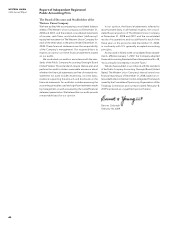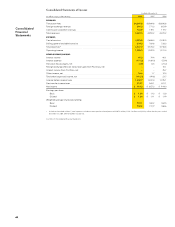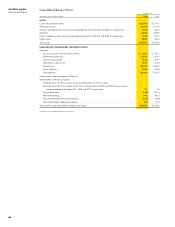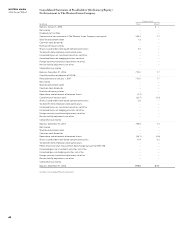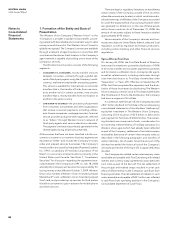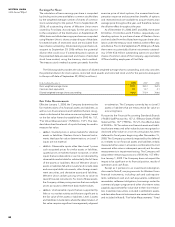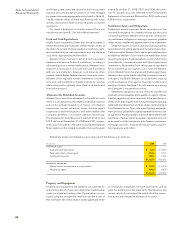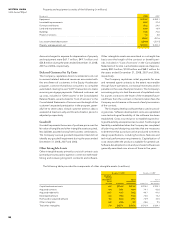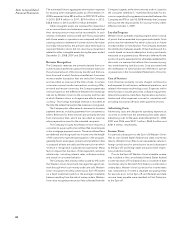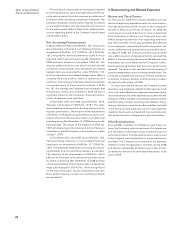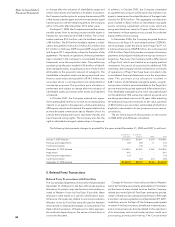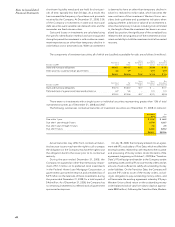Western Union 2008 Annual Report Download - page 53
Download and view the complete annual report
Please find page 53 of the 2008 Western Union annual report below. You can navigate through the pages in the report by either clicking on the pages listed below, or by using the keyword search tool below to find specific information within the annual report.5151
Notes to Consolidated
Financial Statements
As part of the Spin-off, the Company also executed
several non-cash transactions, including the issuance of
$1.0 billion in notes to First Data in partial consideration
for the contribution by First Data to the Company of its
money transfer and consumer payments businesses (Note
15). The Company did not receive any proceeds from
the subsequent private offering of the notes. In addition,
First Data transferred to the Company its headquarters in
Englewood, Colorado and certain other fixed assets with a
net book value of $66.5 million, the Company transferred
to First Data certain investments with a net book value of
$20.9 million, and reclassified certain tax and employee-
related obligations from intercompany liabilities totaling
$193.8 million. First Data also distributed 765.3 million
shares of Western Union’s common stock to holders of
First Data common stock.
Basis of Presentation
The financial statements in this Annual Report for periods
ending on or after the Distribution are presented on a con-
solidated basis and include the accounts of the Company
and its majority-owned subsidiaries. The financial state-
ments for the period presented prior to the Distribution
are presented on a combined basis and represent those
entities that were ultimately transferred to the Company
as part of the Spin-off. The assets and liabilities presented
have been reflected on a historical basis, as prior to the
Distribution such assets and liabilities presented were
100% owned by First Data. The Consolidated Statement
of Income for the year ended December 31, 2006 includes
expense allocations for certain corporate functions histori-
cally provided to Western Union by First Data, including
treasury, tax, accounting and reporting, mergers and
acquisitions, risk management, legal, internal audit, pro-
curement, human resources, investor relations and infor-
mation technology. If possible, these allocations were
made on a specific identification basis. Otherwise, the
expenses related to services provided to Western Union
by First Data were allocated to Western Union based on
the relative percentages, as compared to First Data’s other
businesses, of headcount or other appropriate methods
depending on the nature of each item of cost to be allo-
cated. However, the financial statements for the period
presented prior to the Distribution do not include all of
the actual expenses that would have been incurred had
Western Union been a stand-alone entity during the period
presented and do not reflect Western Union’s combined
results of operations and cash flows had Western Union
been a stand-alone company during the period presented.
All significant intercompany transactions and accounts
have been eliminated.
Consistent with industry practice, the accompanying
Consolidated Balance Sheets are unclassified due to the
short-term nature of Western Union’s settlement obliga-
tions contrasted with the Company’s ability to invest cash
awaiting settlement in long-term investment securities.
2. Summary of Significant
Accounting Policies
Use of Estimates
The preparation of financial statements in conformity with
accounting principles generally accepted in the United
States of America (“GAAP”) requires management to
make estimates and assumptions that affect the amounts
reported in the financial statements and accompanying
notes. Actual results could differ from these estimates.
Principles of Consolidation
Western Union consolidates financial results when it will
absorb a majority of an entity’s expected losses or residual
returns or when it has the ability to exert control over the
entity. Control is normally established when ownership
interests exceed 50% in an entity. However, when Western
Union does not have the ability to exercise control over a
majority-owned entity as a result of other investors having
contractual rights over the management and operations
of the entity, it accounts for the entity under the equity
method. As of December 31, 2008 and 2007, there were
no greater-than-50%-owned affiliates whose financial state-
ments were not consolidated. Western Union utilizes the
equity method of accounting when it is able to exercise
significant influence over the entity’s operations, which
generally occurs when Western Union has an ownership
interest of between 20% and 50% in an entity.
Restructuring and Related Expenses
The Company records severance-related expenses once
they are both probable and estimable in accordance
with the provisions of Statement of Financial Accounting
Standards (“SFAS”) No. 112, “Employers’ Accounting for
Post-Employment Benefits” for severance provided under
an ongoing benefit arrangement. One-time, involuntary
benefit arrangements and other exit costs are accounted
for under the provisions of SFAS No. 146, “Accounting for
Costs Associated with Exit or Disposal Activities.” Costs
arising under the Company’s defined benefit pension
plans from curtailing future service of employees par-
ticipating in the plans and providing enhanced benefits
are accounted for under the provisions of SFAS No. 88,
“Employers’ Accounting for Settlements and Curtailments of
Defined Benefit Pension Plans and for Termination Benefits.”
The Company also evaluates impairment issues associated
with restructuring activities under the provisions of SFAS
No. 144, “Accounting for the Impairment or Disposal of
Long-Lived Assets.” Restructuring and related expenses
consist of direct and incremental costs associated with
restructuring and related activities, including severance,
outplacement and other employee related benefits; facility
closure and migration of the Company’s IT infrastructure;
other expenses related to relocation of various operations
to existing Company facilities and third-party providers,
including hiring, training, relocation, travel and professional
fees. Also included in facility closure expenses are non-cash
expenses related to fixed asset and leasehold improvement
write-offs and acceleration of depreciation and amortiza-
tion. For more information on the Company’s restructur-
ing and related expenses see Note 3, “Restructuring and
Related Expenses.”





